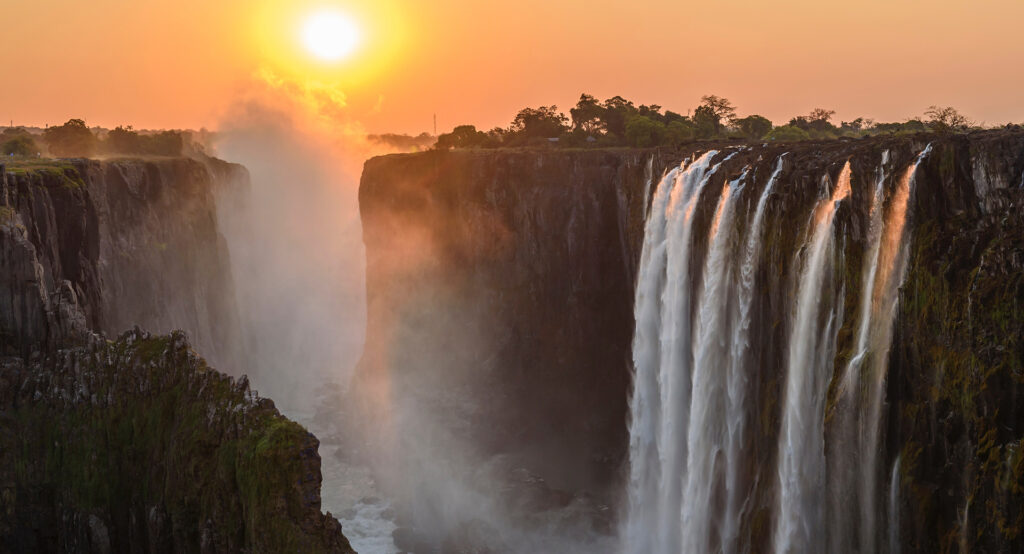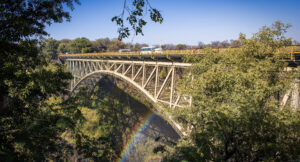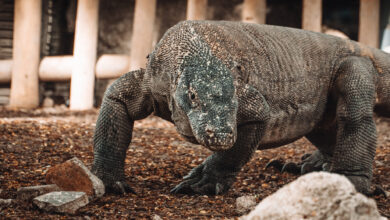20 Intriguing Facts About Victoria Falls
Victoria Falls is one of the most magnificent natural wonders of the world, located on the Zambezi River on the border of Zambia and Zimbabwe in southern Africa. It is the largest waterfall in the world by total area and one of the most popular tourist destinations in Africa. Here are some interesting facts about Victoria Falls:

Victoria Falls is one of the largest waterfalls in the world.
1 Located on the Zambezi River on the border between Zambia and Zimbabwe in Africa. It is approximately 1,708 meters wide and 108 meters tall, making it almost twice the height of Niagara Falls.
The falls are considered one of the Seven Natural Wonders of the World and are a UNESCO World Heritage Site.
2 Which is a list of the world’s most awe-inspiring natural wonders, chosen by a global poll of experts and the public.
The other natural wonders on the list include the Grand Canyon in the United States, the Great Barrier Reef in Australia, Mount Everest on the border of Nepal and Tibet, Parícutin volcano in Mexico, Rio de Janeiro’s harbor in Brazil, and the Aurora Borealis in the Arctic Circle.
Victoria Falls is recognized for its incredible size, beauty, and unique location, which make it a popular tourist destination and a natural wonder of the world.
Victoria Falls is approximately 1,708 meters (5,604 feet) wide and 108 meters (354 feet) tal.
3 Making it one of the largest and most impressive waterfalls in the world. The falls are located on the Zambezi River on the border between Zambia and Zimbabwe in Africa, and are known for their thundering roar, misty spray, and stunning views.
The falls are twice the height of Niagara Falls and are one of the most popular tourist destinations in Southern Africa.
Visitors can view the falls from various vantage points on both sides of the border, as well as participate in various activities such as bungee jumping, whitewater rafting, and helicopter tours.
“Mosi-oa-Tunya”
is the indigenous name for Victoria Falls
4 Which is located on the Zambezi River at the border between Zambia and Zimbabwe.
The name comes from the local Tonga language and means “The Smoke That Thunders,” referring to the mist and loud roar created by the waterfall’s powerful descent.
The name is a beautiful and poetic way to describe one of the most magnificent natural wonders of the world.
Scottish explorer and missionary David Livingstone was the first European to see Victoria Falls on November 16, 1855.
5 Livingstone named the falls after Queen Victoria of England, who was the reigning monarch at the time.
Livingstone was exploring the region as part of his mission to map out the interior of Africa and to promote commerce and the abolition of slavery.
He was awestruck by the beauty and power of the falls and described them as “scenes so lovely must have been gazed upon by angels in their flight.”
Livingstone’s discovery of Victoria Falls helped to put it on the world map and attract visitors and explorers from around the globe.
The Victoria Falls are located on the border between Zambia and Zimbabwe, and the area around the falls is protected by two national parks.
6 The Mosi-oa-Tunya National Park is located on the Zambian side of the falls, while the Victoria Falls National Park is on the Zimbabwean side.
Both parks were established to protect the natural beauty and biodiversity of the area, which is home to a variety of plant and animal species, including elephants, buffalo, giraffes, and numerous species of birds.
The parks offer visitors the opportunity to see the falls up close, as well as to enjoy other activities such as game drives, river cruises, and cultural experiences.
The best time to visit Victoria Falls depends on what you want to experience.
7 The period from February to May is considered the best time to visit for viewing the falls at their fullest, as this is the rainy season in the region and the water flow is at its highest.
During this time, the falls are at their most dramatic and the mist and spray created by the falling water can be seen from miles away.
However, if you prefer a quieter experience with fewer crowds and lower prices, you may want to consider visiting outside of this peak season. From June to August, the falls are still impressive and the weather is cooler and drier, making it a good time for outdoor activities such as hiking and wildlife viewing.
From September to November, the water levels begin to drop, but the weather is still pleasant and the falls are still worth seeing.
It’s important to note that during the peak season, the crowds can be quite large and accommodations may be more expensive, so it’s a good idea to book well in advance if you plan to visit during this time. Additionally, the mist and spray created by the falls can make it difficult to get good photos or to stay dry, so be prepared with appropriate clothing and camera equipment.
Activities available for tourists at Victoria Falls.
8 Here are some of the most popular ones:
View the Falls: The primary reason for visiting Victoria Falls is to see the falls themselves. Visitors can take guided tours to view the falls from various viewpoints on both the Zambian and Zimbabwean sides of the border.
- Helicopter Flights: For a bird’s eye view of the falls, visitors can take a helicopter or microlight flight over the falls. These flights offer spectacular views of the falls and the surrounding landscapes.
- Bungee Jumping: Adrenaline junkies can experience the ultimate thrill by bungee jumping from the Victoria Falls Bridge, which spans the Zambezi River between Zimbabwe and Zambia.
- White-water Rafting: The rapids below the falls are some of the best in the world, offering exciting rafting experiences for both beginners and experts.
- Safari: Visitors can take game drives or walking safaris in the nearby national parks to see a variety of African wildlife, including elephants, lions, and zebras.
- River Cruises: The Zambezi River offers a tranquil way to experience the beauty of the region, with river cruises and sunset cruises available to see hippos, crocodiles, and other wildlife.
- Cultural Experiences: Visitors can also experience the local culture and traditions of the people living near Victoria Falls by visiting nearby villages and markets, attending traditional dance performances, and trying local foods.
The area around Victoria Falls is home to a diverse range of wildlife, including both large mammals and smaller species.
9 The two national parks that surround the falls, Mosi-oa-Tunya National Park in Zambia and Victoria Falls National Park in Zimbabwe, are home to many different species of animals.
Some of the larger mammals that can be seen in the area include elephants, buffalos, giraffes, zebras, hippos, and crocodiles. There are also several species of antelope, such as impalas, kudus, and bushbucks, as well as predators such as lions, leopards, and hyenas.
In addition to the larger mammals, the area is also home to a diverse range of bird species. Over 400 species of birds have been recorded in the region, including eagles, vultures, storks, herons, and kingfishers.
The diversity of wildlife in the area makes it a popular destination for wildlife enthusiasts and photographers, who come to see and capture the unique beauty of these animals in their natural habitats. Wildlife viewing opportunities are available through game drives, walking safaris, river cruises, and other activities offered by tour operators in the area.
The local currency used in Zimbabwe is actually no longer the Zimbabwean dollar.
10 The government of Zimbabwe abandoned the Zimbabwean dollar due to hyperinflation, and it was replaced with a basket of foreign currencies such as the US dollar, the South African rand, and the British pound.
In June 2019, the government introduced a new currency called the Zimbabwean RTGS dollar, which has since been renamed the Zimbabwean dollar.
However, the currency has faced significant challenges and is not widely accepted by international merchants or used for transactions outside of Zimbabwe.
For this reason, visitors to Zimbabwe often rely on foreign currencies such as the US dollar, the euro, or the South African rand for transactions, including entrance fees to Victoria Falls National Park, accommodation, and other expenses.
It’s a good idea to have a mix of cash and credit/debit cards when traveling to Zimbabwe and to check the current exchange rates before your trip.
The spray from Victoria Falls can be seen from up to 50 km away, earning it the nickname “The Smoke that Thunders”.
11 The spray is created by the force of the water from the Zambezi River as it plunges over the falls and hits the rocks below, creating a mist that rises high into the air.
The spray can be so thick and heavy that it can be difficult to see the falls themselves from certain viewpoints.
In fact, during the peak flow of the Zambezi River, which usually occurs from around February to May, the spray can rise up to 400 meters high and be visible from even greater distances.
The spray is one of the many stunning natural features of Victoria Falls that draws visitors from all over the world to see this incredible wonder of nature.
The falls are the result of the Zambezi River plummeting into a deep, narrow gorge, creating a magnificent sight.
12 The Zambezi River flows across a wide, flat plateau before it reaches the falls, which are located on the border between Zambia and Zimbabwe.
At the falls, the river drops over a vertical cliff that is over 100 meters high and stretches for more than 1.7 kilometers. The water plunges into a narrow gorge below, which creates a thunderous roar and a massive spray that can be seen from kilometers away. The gorge that the water flows into is up to 100 meters deep, and it has been eroded by the water over millions of years.
The combination of the height, width, and volume of water flowing over the falls creates a unique and awe-inspiring sight that is one of the most popular natural wonders in the world.
Visitors to Victoria Falls can view the falls from multiple viewpoints, including from both the Zambian and Zimbabwean sides of the border, and can also experience the falls from the air or on the water through a range of activities offered in the area.
The Devil’s Pool, a natural infinity pool on the edge of the falls, is a popular attraction for visitors who want to swim on the edge of the waterfall.
13 During the dry season when the water levels are low, a natural rock barrier forms a shallow pool at the edge of the falls, creating a natural infinity pool that is safe to swim in.
Visitors can access the pool via a guided tour, which involves a short boat trip to Livingstone Island followed by a swim across the pool to the edge of the falls.
Swimming in Devil’s Pool is an exhilarating experience, as you are able to look over the edge of the falls and experience the full force of the water rushing over the cliff.
However, it is important to note that swimming in the pool is only safe during the dry season when the water levels are low, and it should only be done with a guide who is familiar with the area and safety procedures.
Victoria Falls is an important source of hydroelectric power for both Zambia and Zimbabwe.
14 The falls are located on the Zambezi River, which provides a significant amount of water to generate hydroelectric power.
On the Zambian side of the border, the Zambian Electricity Supply Company (ZESCO) operates a hydroelectric power station that generates electricity for the local area.
On the Zimbabwean side, the Zimbabwe Power Company operates the Victoria Falls Power Station, which was built in the 1950s and 1960s and has an installed capacity of 108 MW.
The hydroelectric power generated from Victoria Falls is a valuable source of renewable energy for both Zambia and Zimbabwe, providing a reliable source of electricity for homes, businesses, and industries in the region.
In addition to providing power, the falls also serve as a major tourist attraction and an important source of income for the local economy.
The Zambezi River above and below the falls is home to some of the best freshwater sport fishing in the world.
15 The river is home to a variety of fish species, including the famous tigerfish, which is a highly prized game fish known for its aggressive strikes and acrobatic fights.
Fishing on the Zambezi River can be done in a variety of ways, including fly fishing, spin casting, and bait fishing. There are a number of fishing lodges and outfitters in the area that offer guided fishing trips, equipment rental, and accommodation for anglers.
In addition to tigerfish, other species of fish that can be caught in the Zambezi River include bream, catfish, tilapia, and vundu. Fishing on the river is strictly regulated to protect fish populations and ensure sustainable fishing practices, and it is important for anglers to adhere to these regulations to preserve the ecosystem.
Fishing on the Zambezi River is a popular activity for visitors to Victoria Falls, and it provides a unique opportunity to experience the natural beauty and wildlife of the area while enjoying some of the best freshwater sport fishing in the world.
The Victoria Falls Bridge, completed in 1905, spans the Zambezi River and links the town of Victoria Falls in Zimbabwe to Livingstone in Zambia.
16 The bridge was designed by George Andrew Hobson of the consulting firm Sir Douglas Fox and Partners and was constructed by the Cleveland Bridge & Engineering Company.
The Victoria Falls Bridge is an impressive feat of engineering and is considered a significant landmark in the history of southern Africa. At the time of its construction, it was the highest railway bridge in the world and was also used as a roadway for vehicle traffic.
Today, the bridge serves as a major tourist attraction, offering breathtaking views of the falls and the Zambezi River. Visitors can take a guided tour of the bridge, including a walk along the catwalks beneath the bridge and a bungee jump or zipline off the bridge for an adrenaline-filled experience.
The Victoria Falls Bridge is also an important transportation link between Zimbabwe and Zambia, with trains and vehicles crossing the bridge on a regular basis. The bridge is a symbol of the close ties between the two countries and is an important piece of infrastructure in the region.
The area around Victoria Falls has a rich and diverse history that spans thousands of years.
17 The falls themselves have been known to the indigenous peoples of the area for centuries, and the local Tonga people have a rich tradition of folklore and spiritual beliefs surrounding the falls.
In the late 19th century, the area around Victoria Falls became a major focus of European exploration, with numerous expeditions venturing into the region in search of adventure and scientific discovery.
The Scottish explorer David Livingstone is perhaps the most famous of these early explorers, and he is credited with “discovering” the falls and bringing them to the attention of the Western world.
The region also played an important role in the colonial history of southern Africa, with the falls and the Zambezi River serving as important transportation and trade routes.
The Victoria Falls Bridge, which links Zimbabwe and Zambia, was built as part of the Cape-to-Cairo railway project, which was intended to connect the British colonies of southern and central Africa.
In the post-colonial era, the area around Victoria Falls has continued to be a focus of tourism and economic development, with visitors from around the world coming to experience the natural beauty of the falls and the surrounding wilderness.
Today, the falls are a UNESCO World Heritage Site and continue to be an important cultural and historical landmark in southern Africa.
The Victoria Falls area is home to several indigenous tribes, including the Tonga people, who have lived in the region for centuries.
18 The Tonga people have a rich cultural heritage and a deep spiritual connection to the falls, which they refer to as Mosi-oa-Tunya, or “The Smoke That Thunders.”
In addition to the Tonga people, the area around Victoria Falls is home to several other indigenous tribes, including the Batoka, the Lozi, and the Luvale, among others. These tribes have their own unique cultural traditions and languages, and they have lived in the region for thousands of years.
Despite the impact of colonialism and modernization, many of these indigenous communities have managed to preserve their cultural heritage and traditional way of life. They continue to practice traditional farming, fishing, and hunting methods, and they maintain a strong spiritual connection to the land and the natural environment.
Visitors to Victoria Falls have the opportunity to learn about the cultural traditions and way of life of these indigenous communities through guided tours and cultural experiences. These interactions can provide a deeper understanding of the history and cultural richness of the region, and can be a valuable and enriching experience for visitors.
The Victoria Falls Marathon, a popular international marathon, takes place annually in June and attracts runners from all over the world.
19 The marathon course takes runners through some of the most spectacular scenery in the region, including the Zambezi River, the Victoria Falls Bridge, and the surrounding national parks.
The Victoria Falls Marathon is recognized as one of the most scenic marathons in the world, with breathtaking views of the falls and the surrounding wilderness. The race is also known for its festive atmosphere, with live music and entertainment along the course and at the finish line.
In addition to the full marathon, the event also includes a half marathon and a fun run, making it accessible to runners of all levels. The race is organized by the Victoria Falls Marathon Trust, and proceeds from the event are used to support local community projects in the area.
For runners and spectators alike, the Victoria Falls Marathon is a unique and unforgettable experience that combines the excitement of international competition with the beauty and wonder of one of the world’s natural wonders.
The Zambezi River, which feeds Victoria Falls, is the fourth-longest river in Africa, after the Nile, the Congo, and the Niger rivers.
20 It is approximately 2,700 km (1,700 mi) long and flows through six countries in southern Africa: Zambia, Angola, Namibia, Botswana, Zimbabwe, and Mozambique.
One of the unique features of the Zambezi River is that it is the longest east-flowing river on the continent. This means that it flows from west to east, starting in the highlands of Zambia and ending in the Indian Ocean off the coast of Mozambique.
The Zambezi River is an important water source for the region, providing drinking water, irrigation, and hydroelectric power to millions of people. It is also a vital habitat for a wide variety of plant and animal species, including several endemic species that are found nowhere else in the world.
In addition to its importance as a water source and habitat, the Zambezi River is also a popular destination for outdoor activities, including white-water rafting, kayaking, and fishing. The river is known for its rapids, which range from Class II to Class V, making it a thrilling destination for adventure-seekers.




